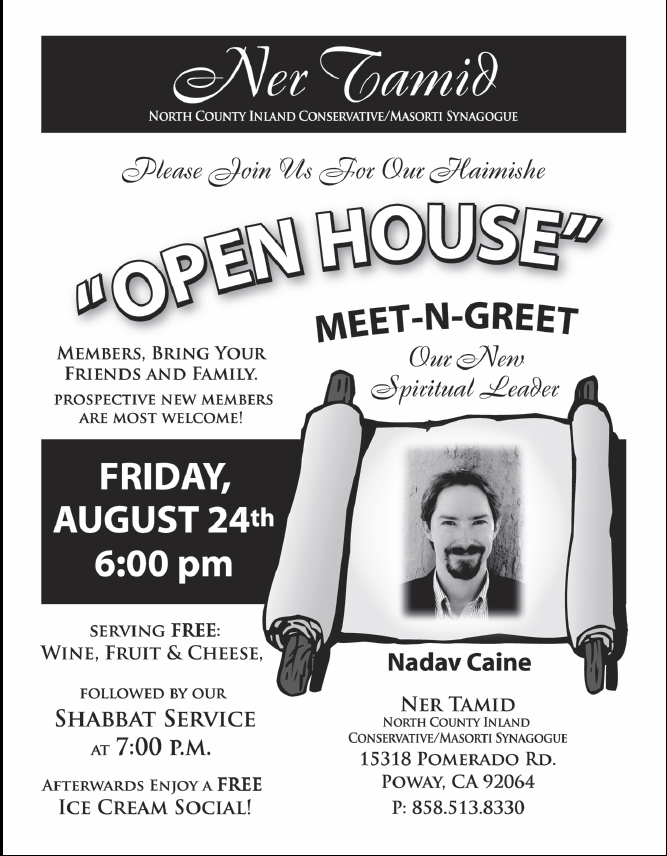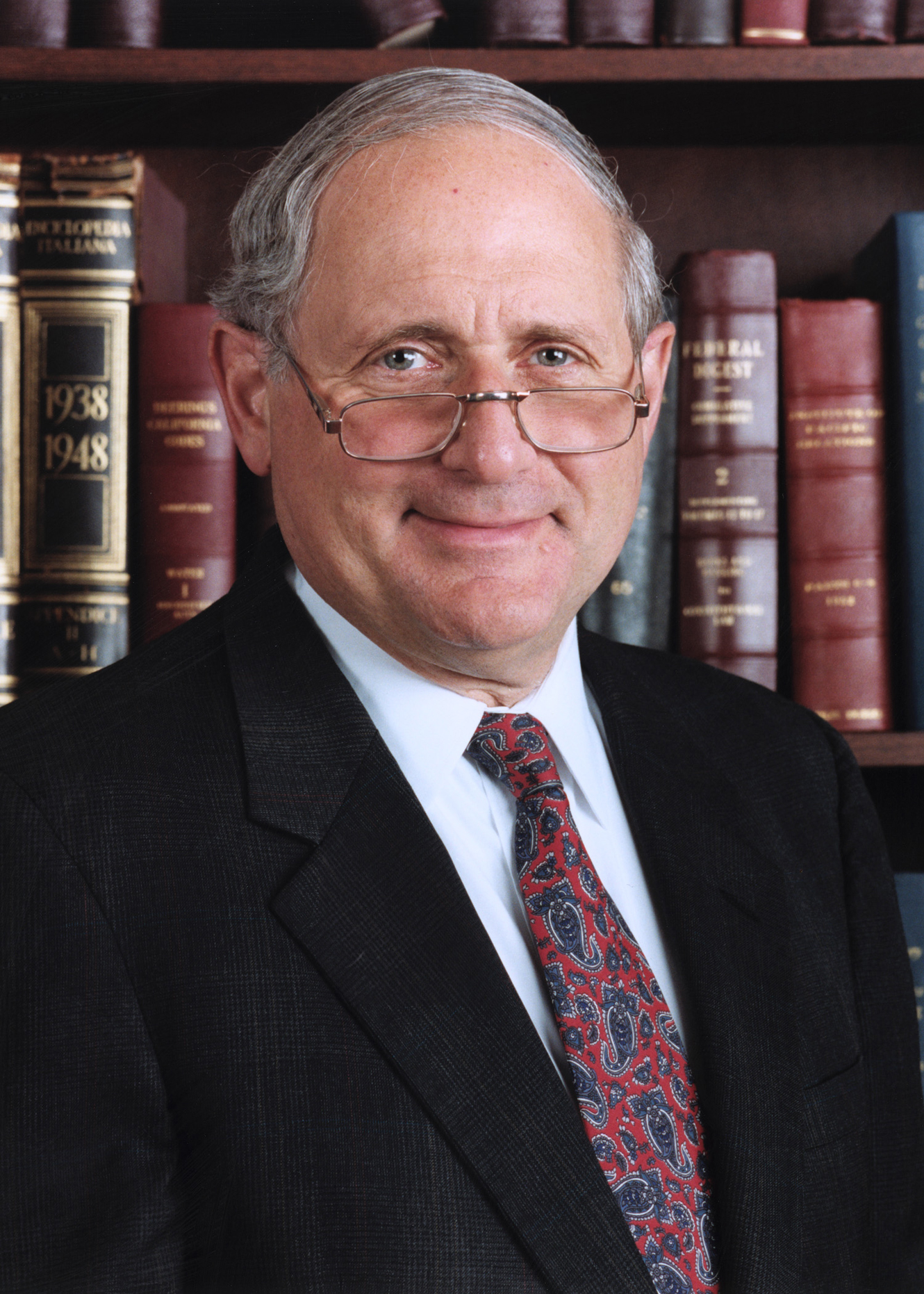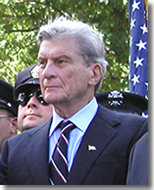
Please click on the above ad to
visit the Humanistic Jewish
Congregation's website
The Jewish Grapevine  |
CONGREGATIONAL CURRENTS—The landlord of the property on which Chabad of La Costa operates its shul has agreed to sell the land for $300,000, which is below market value, according to Rabbi Yeruchem Eilfort. Now the congregation in launching a fundraising drive, not only for the land but for a permanent structure that might be built there. Rabbi Shlomo Cunin, director of Chabad of the West Coast, has agreed to augment every contribution to this fund by 10 percent, Eilfort reported. More information may be obtained from Chabad at La Costa at (760) 612-4577.
CYBER-REFERRALS—Abe & Bea Goldberg were moved, and so were we, by this non-sectarian pleas for adult children to please be patient and tolerant of their elderly parents. Here is a link ... Jay Jacobson forwards to us an article by Bob Feferman on the website of Scholars for peace in the Middle East about some of the rationale behind the proposed British boycott of Israeli academic institutions. Here is the link. ...
 JEWISH PUBLIC OFFICIALS—Fox News reported today that following a shoving incident at the airport in Washington D.C. between
JEWISH PUBLIC OFFICIALS—Fox News reported today that following a shoving incident at the airport in Washington D.C. between
Bob Filner
a link to an expanded version. Our thanks to Steve Griffin for alerting us to the story... California State Insurance Commissioner Steve Poizner has announced the capture in Georgia of Norman Hugh Baker, 52, of Torrance, California, who was convicted of bilking homeowners out of their insurance payments for rain damage. He fled the state before his sentencing date in California. "I am committed to protecting consumers from criminals who will stop at nothing for a quick buck," said Commissioner Poizner. "Anyone considering stealing from hard-working Californians should think twice and beware that Department of Insurance investigators are not far behind them."
 SAN DIEGO JEWISH HISTORY—One of the more enjoyable magazines in town is Save Our Heritage, with color layouts of interesting historical buildings. The current issue focuses on San Diego's Historic Warehouse District. Among buildings illustrated in an article by Bruce Coons, SOHO's executive director, are the Simon Levi Building at 7th and J Streets in San Diego, and Levi Wholesale Grocery Co. They were built in 1916 and 1927 respectively. Another article in the magazine, compiled by Coons' wife, Alana, discusses the economics of historic preservation. Illustrating that piece is a photo of the twin-towered Louis Bank of Commerce, built in 1888 for Isador Louis in what today we call the Gaslamp Quarter. Another article entitled the "2007 Most Endangered List" tells of 12 properties that SOHO fears are facing threats to their historic context. Among these is the 1965 Salk Institute for Biological Studies, which grew out of a conceptual partnership between architect Louis Kahn and polio vaccine discover Jonas Salk. According to the SOHO article: "Entitlements are being sought this year for an insensitive Master Plan that would permanently alter the world-renowned Salk Institute for Biological Studies... Inconsistent with Kahn's original site plan and design, the master plan threatens to max out the property in a manner that would permanently compromise its prized architectural, historical and environmental values. This would include views to and from the iconic Kahn laboratory buildings and the magnificent courtyard space."... We also take note that among 2007 "People in Preservation Award Winners" cited by the organization were Louis & Tammy Vener, who adopted the motto, "out with the new and in with the old" in connection with the preservation, restoration and historic designation of the Uriah and Clara Barkey House. ... Kathleen Dickey, who became a research intern at the San Diego Archaeological Center after retiring as a clinical microbiologist and research scientist, plans a lecture on October 13 at the center (16666 San Pasqual Valley Road, Escondido) on the topic "History on the Rocks: The Story of 160 Acres in the San Pasqual Valley.). So what's Jewish about that? One of the personages in her story was Moses Mannasse, a 19th century settler in San Diego County.
SAN DIEGO JEWISH HISTORY—One of the more enjoyable magazines in town is Save Our Heritage, with color layouts of interesting historical buildings. The current issue focuses on San Diego's Historic Warehouse District. Among buildings illustrated in an article by Bruce Coons, SOHO's executive director, are the Simon Levi Building at 7th and J Streets in San Diego, and Levi Wholesale Grocery Co. They were built in 1916 and 1927 respectively. Another article in the magazine, compiled by Coons' wife, Alana, discusses the economics of historic preservation. Illustrating that piece is a photo of the twin-towered Louis Bank of Commerce, built in 1888 for Isador Louis in what today we call the Gaslamp Quarter. Another article entitled the "2007 Most Endangered List" tells of 12 properties that SOHO fears are facing threats to their historic context. Among these is the 1965 Salk Institute for Biological Studies, which grew out of a conceptual partnership between architect Louis Kahn and polio vaccine discover Jonas Salk. According to the SOHO article: "Entitlements are being sought this year for an insensitive Master Plan that would permanently alter the world-renowned Salk Institute for Biological Studies... Inconsistent with Kahn's original site plan and design, the master plan threatens to max out the property in a manner that would permanently compromise its prized architectural, historical and environmental values. This would include views to and from the iconic Kahn laboratory buildings and the magnificent courtyard space."... We also take note that among 2007 "People in Preservation Award Winners" cited by the organization were Louis & Tammy Vener, who adopted the motto, "out with the new and in with the old" in connection with the preservation, restoration and historic designation of the Uriah and Clara Barkey House. ... Kathleen Dickey, who became a research intern at the San Diego Archaeological Center after retiring as a clinical microbiologist and research scientist, plans a lecture on October 13 at the center (16666 San Pasqual Valley Road, Escondido) on the topic "History on the Rocks: The Story of 160 Acres in the San Pasqual Valley.). So what's Jewish about that? One of the personages in her story was Moses Mannasse, a 19th century settler in San Diego County.

{Click the above ad for more information
|
Sports |
 News from the Israel Baseball League |
expatriate Americans are very pleased to have it
By Yoni Peres
(Editor's Note: Stories about Bet Shemesh's 3-0 victory over Modi'in and the first IBL awards ceremony
ran in yesterday's edition; here is a story from the perspective of a new Israeli fan.)
PETACH TIKVA, Israel—None of my friends wanted to join me for the IBL championship game, although I had free tickets. Has baseball not been exposed enough to the Israeli public? Probably so. My mother in law, Daliah, volunteered to come along and even helped me to take some photos.
The ceremony began with the singing of Hatikvah by the talented Hillel Sheinfeld. Later on, behind the stands, I discovered that apart from being a chazan at his shul, Hillel is also the owner of the "Burgers Bar " in Bet Shemesh, and is responsible for the huge burgers, hotdogs and schnizles, sold at the Yarkon field snack bar.
Hillel made aliyah from Long Island five years ago, and seemed very happy at the game, just like hundreds of ex American Jews who came to cheer the two teams. Next to me, a lady from Modi'in, finds common acquaintances with the visitor from Highland Park, Illinois, sitting next to her. "Of course I know the Lefkowitzes" they live two blocks away from me" etcetera.
|
|
|
|
BASEBALL, ISRAEL STYLE—Burgers make you strong, says vendor Hillel Sheinfeld, who sang Hatikvah at the beginning of the game. Stands sit by the announcer's table. Shalom Lerner, deputy mayor of Bet Shemesh, shows the IBL championship trophy to Daliah Shalev, the mother-in-law of writer Yoni Peres.
Fans sitting next to me, look at me with mercy and try to explain the rules of the game, which now have Hebrew terminology. At the VIP stand, the league’s originator, Larry Baras was delighted, watching the easy victory by the Bet Shemesh Blue Socks.
Next to him were the commissioner, Dan Kurtzer
(former US ambassador to Israel), some other IBL executives and the deputy mayor of Bet Shemesh - Shalom Lerner.
I think we should give a huge " Kol Hakavod" to Baras . His achievement, in such a short time, is amazing.
Other players, from the four teams that did not make it to the final were walking around proudly, signing balls' bats and hats. Wearing a souvenir Israeli police shirt, Josh Doane of the Netanya Tigers said he has had a great experience, but is already homesick and misses his family and friends back in Indianapolis.
At the end of the game, the closing ceremony included presenting the trophy and awarding players for their achievements. Gregg Raymundo, our friend from the Bar Mitzvah story at the Kotel, was one of the MVP's.
We walked to the parking lot to the tune of "Take Me Out to the Ball Game," passing by the booths selling last minute deals of hats, balls, bats etc.
Josh Doane
Nobody was pushing' cursing or arguing. There was no sound of car horn as the cars were leaving the parking lot. Are
we really in Israel? I asked Daliah
Well, we have still a lot to learn from this, and hopefully the day will come when instead of violence and ugly behavior, the fans at our soccer games will show a different pattern.

{Marc Kligman, who combines being a sports agent with his life as an observant Jew, invites you to listen. Click on the ad above for more information}.
|
Arts & Entertainment |
By Eileen Wingard
SAN DIEGO—Four highlights of the recent eighth San Diego Jewish Music Festival included Israel’s remarkable jazz bass player Avishai Cohen and his combo, the Israel Contemporary String Quartet, Pianist Jeffrey Siegel, and the Keshet Chaim Dance Company. Although the festival, sponsored by the San Diego Center for Jewish Culture, stretched from April to August, the four highlights occurred in May and the first week of June.
Avishai Cohen and his combo endeared themselves May 6 to a capacity crowd with their improvisations on Israeli tunes. The music had dynamic texture and included moments of soft, intimate jazz. Cohen demonstrated his virtuosity on the string bass, that most cumbersome and awkward of instruments. In his hands, it was like a cello. This concert was co-sponsored by radio station Jazz 88.
The Israel Contemporary String Quartet, four attractive young Israeli women, played a challenging repertoire on May 21 of contemporary Israeli composers. Yehezkel Braun’s engaging String Quartet showcased both the excellent level of ensemble and the individual mastery of Hadas Fabrikant, violin, Tali Goldberg, violin, Amelia Hollander, viola, and Hilla Epstein, cello. Josef Bardanashvili’s Dance Macabre, a dramatic, wild piece, which pushes the envelope of string technique, left the audience breathless. The second half of the program was much tamer with a gentle rendition of Mozart’s String Quartet in D minor K. 421 and several arrangements of Israeli folk songs.
Pianist Jeffrey Siegel presented on May 24 one of his Keyboard Conversations featuring composers Gottschalk, Gershwin and Bernstein. Siegel’s illuminating comments gave the listeners insight into each work and made music lovers out of the uninitiated. His finale, Gershwin’s Rhapsody in Blue was an exciting tour de force.
Keshet Chaim Dance Company came down from Los Angeles June 2 to entertain with six dances spanning Sephardic, Yeminite, Chassidic and Israeli styles. All six dances were choreographed by Keshet Chaim’s director, Eytan Avisar.
Two offerings, The Yeminites and Sababa Ba Midbar also credited two members of
the company as collaborating choreographers. The company was spirited and
energetic with colorful costumes and appropriate music. Gilat Rapaport, a
charming vocalist, sang between dance numbers, allowing the performers time to change costumes.
That evening of dance was dedicated to the memory of Sandra Kritzik, a member of the JCC Music Committee who herself was a dancer and a devoted supporter of the arts.
There were several free programs. These included two evenings, April 18 and 19 showing Part I and Part II of the documentary We Want the Light. Following the first showing, Nuvi Mehta led a discussion on Wagner and the Jews.
Clarinet Virtuoso Marian Liebowitz, professor of music at San Diego State University, performed a recital of music by Jewish composers, and commented about Jewish philanthropy.
The Twilight in the Park program June 27 featured a jazz combo sponsored by Jazz 88 and Yale Strom’s Hot Pstromi klezmer group. The jazz group played first, then Strom's group followed. In the final number, both groups combined in a rendition of Bei Mir Bistu Sheyn with Elizabeth Schwartz singing the lyrics and the jazz combo’s vocalist, Sue Palmer scat-singing along.
The festival concluded with two performances August 5 of ShirLaLa, a program especially designed for the younger set and sponsored by Gepeto’s. ShirLaLa’s Shira Kline and her combo had the children dancing and singing with her Pied Piper magic.
The Eighth Annual San Diego Jewish Music Festival continued to uphold the high standards of pervious years, bringing to San Diego outstanding Jewish talent. The JCC Music Committee, under the chairmanship of Roselyn Pappelbaum, and facilitated by staff Cultural Director Jackie Gmach, has once again presented a winning array of Jewish musical events
|
Story Continuations |
Epileptic seizures...
(Continued from above)
The Epilert consists of a hand (or foot) sensor unit device worn by the patient, ("the size of a watch," said Shaham) which detects movements and vibrations process and identifies it as an epileptic seizure rather than a normal non-epileptic movement.
"Our unique algorithms differentiate epileptic movements from non-epileptic movements," explained Shaham.
Once positively identified as an attack the sensor transmits an alarm to an alert unit that is with or near the caregiver, similar to a baby monitor. There could be several alert units in various places in a house or a facility, he added.
The idea for the Epilert was borne out of a real problem that Kramer, director of the pediatric epilepsy service at Tel-Aviv Sourasky Medical Center (Ichilov) Hospital, confronted on a daily basis in his work: the fear of parents that a child will suffer from an epileptic attack when alone or in his sleep, without them attending and when it goes on for several hours it can cause irreversible brain damage and even death.
"Professor Kramer also maintains a private clinic treating mainly children, and has a deep understanding of the needs of epileptic children and their families. A couple of years ago a mutual friend got us together, and Kramer explained to me the need for an alert system for his epilepsy patients," said Shaham, an electronic engineer and entrepreneur who graduated the elite 8200 unit in the Israel Defense Forces "many years ago" and was a former executive at Elisra, a top Israeli security and weapons company
Since ending his tenure at Elisra about 10 years ago, Shaham has managed startups, so he was in an ideal position to begin developing Kramer's 'dreams' into practice.
With just the idea of the Epilert on paper, Shaham and Kramer won a 'Start Up is Born' contest sponsored by Israeli daily paper Ma'ariv in January 2005, beating out 700 other submission for the $90,000 first prize money.
"That got the company launched, got our studies and a patent process going," said Shaham. "And at the beginning of this year, we received an additional investment of $100,000, which will help us move forward in developing the device."
Then in June, BioLert, received a big "ego" boost by winning an annual prestigious British award - the 'Medical Futures Innovation Award for Best Medical Device'. Medical Futures (MF IA) is an organization sponsored by pharmaceutical companies and the UK government in order to promote medical innovations.
"There were about 1000 entries in several categories and in our category of 'mental health and neuroscience innovation', we were one of four winners, and the winner of the Best Medical Device'. The next day there was a little article in the Daily Mail, and I immediately started getting emails and telephone calls. People went to the trouble of calling the paper and looking for our address. All were willing to buy the device, and were disappointed to learn it wasn't ready yet," said Shaham.
He hopes to rectify that situation, and within a short time complete the prototype of the Epilert and begin trials at Ichilov under Kramer's supervision.
"Israel's a great place to test this, because the country's small and the population with epilepsy and their physicians is easily accessible. Professor Kramer knows all the relevant neurologists, and in few days, you can get to all of them," he said.
"There's no doubt the need is there, and this solution is unique. It is enthusiastically supported by all the neurologist and epileptologist that we talked to, in Israel and abroad" concluded Shaham." We ran a small survey via a neurology clinic in the US and 80% of the people with children with epilepsy said they would use such a device. Similar results were received on a same survey in Israel.
"A warning has to be issued - whether it's from a child to his parent, an adult to his caregiver or if it's in the hospital to a nurse. The goal is to get there within a minute, and to be there with the patient. And that can save lives."
The preceding story was provided by Israel's Ministry of Foreign Affairs courtesy of http://www.israel21c.org
The meetings in Jordan included consultations with the U.S. Ambassador and members of his staff, as well as Jordanian officials and members of the Iraqi Parliament. We also wanted to gain more knowledge about Iraqi citizens currently residing in Jordan and met with a senior official with the United Nations High Commissioner for Refugees, the Amman office of Save the Children, and a group of Iraqis currently residing in Jordan.
Most important, we continue to be in awe of the dedication, commitment, and courageous performance of our troops, wherever they are in Iraq, and government and private sector civilians who risk their lives daily to give Iraqis the chance to build their nation. Their heroism cannot be overstated.
We have seen indications that the surge of additional brigades to Baghdad and its immediate vicinity and the revitalized counter-insurgency strategy being employed have produced tangible results in making several areas of the capital more secure. We are also encouraged by continuing positive results -- in al Anbar Province, from the recent decisions of some of the Sunni tribes to turn against al Qaeda and cooperate with coalition force efforts to kill or capture its adherents. We remain concerned, however, that in the absence of overall “national” political reconciliation, we may be inadvertently helping to create another militia which will have to be dealt with in the future.
We note the continuing improvement in the ability and willingness of the Iraqi Army to conduct combat operations against the insurgents, but remain concerned about the lack of experience of some of its leadership and the lack of critical military capabilities needed before more of its units can operate independently. Chief among these are modern small arms, artillery, combat and lift aviation, explosive ordnance disposal, transportation assets, and engineer capability essential for force protection. Logistics capabilities are virtually non-existent and are a major hindrance to independent action.
We were also informed of problems within our own United States bureaucracy which are hindering the delivery of badly needed military equipment for Iraqi forces purchased with Iraqi funds through the Foreign Military Sales program. We will be looking into that problem and urge the Secretaries of Defense and State to take immediate action to cut through the red tape that is delaying those purchases.
While we believe that the “surge” is having measurable results, and has provided a degree of “breathing space” for Iraqi politicians to make the political compromises which are essential for a political solution in Iraq, we are not optimistic about the prospects for those compromises. We were in Iraq both during the recent initial meeting of the Iraq Presidency Council, the Prime Minister and the President of the Kurdish region and during the immediately following expanded meeting, which were intended to reach political compromises. We would like to be optimistic that those meetings will lead to substantive progress, however -- given the performance of the Iraqi political leadership to date -- we remain extremely cautious in our expectations, as does our distinguished U.S. Ambassador to Iraq, Ambassador Ryan Crocker.
In many meetings with Iraqi political leaders, of all different backgrounds, we told them of the deep impatience of the American people and the Congress with the lack of political progress, impressed upon them that time has run out in that regard, and told them of the urgent need to make the essential compromises. In all of our meetings we witnessed a great deal of apprehension regarding the capabilities of the current Iraqi government to shed its sectarian biases and act in a unifying manner.
We believe that the recent high-level meetings among Iraqi political leaders could be the last chance for this government to solve the Iraqi political crisis, and should it fail, we believe, the Iraqi Council of Representatives and the Iraqi people need to judge the Government of Iraq’s record and determine what actions should be taken -- consistent with the Iraqi Constitution -- to form a true unity government to meet those responsibilities.
The
preceding story was provided by the offices of Senators
Carl Levin (Democrat, Michigan) and John Warner
(Republican, Virginia), chairman and former chairman of
the Senate Armed Services Committee



 Israeli startup BioLert is minimizing that risk
by developing a warning device called Epilert to support a long
needed remote monitoring solution for people with epilepsy and
their caregivers. Epilert will detect and recognize epileptic
seizures, according to the company's CEO Amos Shaham.
Israeli startup BioLert is minimizing that risk
by developing a warning device called Epilert to support a long
needed remote monitoring solution for people with epilepsy and
their caregivers. Epilert will detect and recognize epileptic
seizures, according to the company's CEO Amos Shaham. 

 We visited forward
operating bases in Mosul and Baghdad. In these areas, as
well as a number of others in Iraq, the military aspects
of President Bush’s new strategy in Iraq, as articulated
by him on January 10, 2007, appear to have produced some
credible and positive results. While visiting U.S.
forces in Baghdad, we visited a Joint Security Station,
a key component of
We visited forward
operating bases in Mosul and Baghdad. In these areas, as
well as a number of others in Iraq, the military aspects
of President Bush’s new strategy in Iraq, as articulated
by him on January 10, 2007, appear to have produced some
credible and positive results. While visiting U.S.
forces in Baghdad, we visited a Joint Security Station,
a key component of





 “These men are heroes,” Sen. Lautenberg said.
“During World War II, they faced hostility within their ranks and on the
battlefield to protect their families and defend our country. Their bravery in
the face of danger was a remarkable tribute to our state and our nation.”
“These men are heroes,” Sen. Lautenberg said.
“During World War II, they faced hostility within their ranks and on the
battlefield to protect their families and defend our country. Their bravery in
the face of danger was a remarkable tribute to our state and our nation.” 
